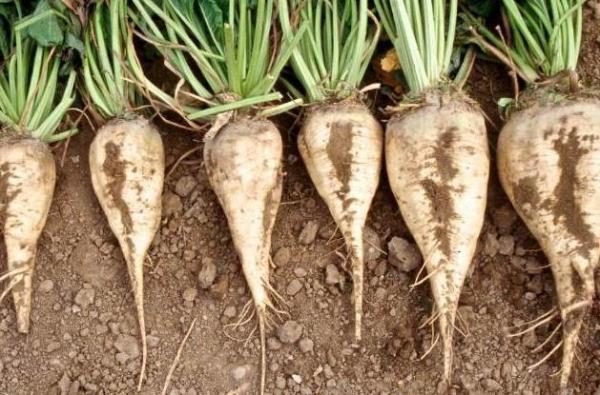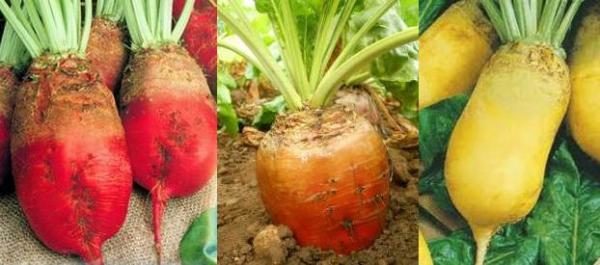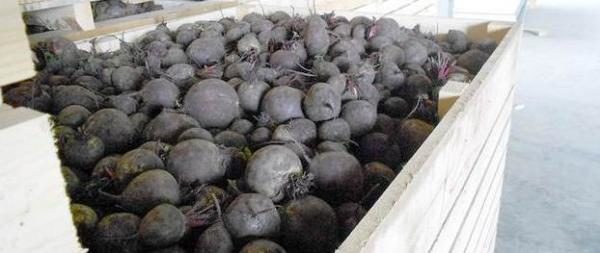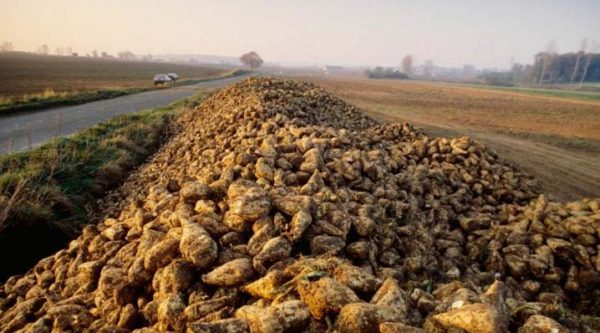Low-calorie fortified root beet (the second name is buryak) is considered the second most popular vegetable after potatoes in our latitudes. Doctors recommend it to people suffering from anemia or cardiovascular disease. Along with iron, the vegetable acts as a natural storage of iodine, calcium, potassium, magnesium, zinc, phosphorus and vitamins of group B.
100 g of the product has 43 calories. Vegetable has several varieties, which will be discussed. The main ones are fodder, sugar and canteen. Species differ in many ways. Those in turn are divided into many varieties.
Table of contents
Two types of beets: their differences and scope
The common ancestor unites varieties - wild beet, which in the 16th century was cultivated by German scientists. The main two types that have been brought out and applied in the farm are now well known: fodder beets intended for animals, and canteen used in cooking.
Only in the 18th century was the technical variety of root crop - sugar. This variety is recommended for food with high blood pressure and cholesterol.
Species Difference - Scope. Sugar beet is a substitute of cane sugar, fodder vegetable has exceptional advantages when feeding cattle. To judge the basic qualities of the two varieties can be based on the names. In the first case, the product is valued due to the high content of sucrose in it, in the second - due to the presence of vegetable protein, vital for animals.
Sugar

For 2 centuries, breeders managed to increase the level of sucrose in the root crop from 5 to 20%. The culture is used to make sugar. The value of the variety in the carbohydrate stock, useful sugars: glucose, fructose, galactose.
Waste remaining after the processing of the crop (beet pulp, molasses and defecate) goes to animal feed or is introduced into the land as lime fertilizer. From 1 centner of vegetable yield from 10 to 15 kg of sugar and up to 6 kg of molasses. Interestingly, the chemical composition of the vegetable depends on many factors: mainly on the climatic conditions and soil fertility.
The root vegetable has received special value due to its high content of folic acid and antioxidants (sugar beet contributes to the digestive processes and lowers blood pressure). Sugar beet does not cause allergic reactions, but contributes to an increase in the level of gastric acidity.
Aft

Fodder culture has less developed fibrous bundles that contain sugar, but it is more saturated with fiber, vitamins (B1, B2, B3, B4, B5 and E) and protein, which play a large role in the diet of dairy cattle, pigs and horses especially in the off season.
In rural areas, the vegetable goes to feed not only large animals, but also poultry: ducks, geese and chickens.
Among other varieties, fodder beet is distinguished by the largest size of the root. Vegetable is classified according to the time of ripening of the crop: early, middle and late varieties are distinguished.
Culture is cultivated in many countries of Europe where animal husbandry is widespread, besides fruits spread to all continentsToday, brown beets are grown even in Australia.
Growing conditions

Aft root crop is shown a few centimeters from the ground, and its roots are almost not recessed into the ground. At the same time, the sugar congener goes deep into the ground to a depth of 3 meters and only elongated smooth leaves with tall petioles are visible above the ground.
Differences in the growing season
To harvest the white beet, from the time of planting seedlings will have to wait up to 170 days. The variety is known to be immune to frost.
The growing season of brown beets is on average 20 days less, its resistance to environmental conditions is weaker.
Peduncles and inflorescences of varieties are the same: during flowering, seedlings can be recognized by small yellow-green flowers. Root crops grow well on loose chernozem and do not like excessive moisture. For the cultivation of crops are not suitable clay and podzolic soils. You can count on a high yield only if the soil is well fertilized with nitrogen, potash and phosphate fertilizers.
Storage methods

If necessary, long-term storage of fodder beet, farmers prefer late varieties such as Cylinder and Renova. After harvesting, the fruits are dried in the open air, laying out the roots on cellophane flooring.
Vegetable stored in wet sand in boxes to prevent drying and wrinkling of vegetables. At the stage of harvesting at root crops, cut the tops to 2 cm and dry.
Sugar beet
It is very important to ensure free access of air to the roots, otherwise the process of decay will begin. The tops are removed to avoid another undesirable process - germination. For storage, only intact sugar root crops are taken and treated with 1% sodium salt solution to suppress the activity of microorganisms. Vegetables are stored in the kagaty, buried in the ground or in warehouses equipped with water supply and ventilation systems.
Stern beet

For storing fodder plants, silage or dry kagata with thermal insulation is used. For long-term storage in kagat, beets are well cooled, and the bottom of kagat is lined with cellophane film. The mound covers 20 cm of straw. For drainage in kagat perform slots. In winter, the root is well kept in a barn, insulated with straw bales.
Interestingly, there is another kind of plant that has found application in animal husbandry and in cooking - leaf beet, in the leaves of which contains up to 25% protein.
